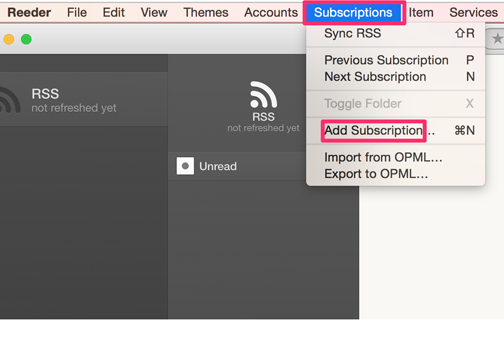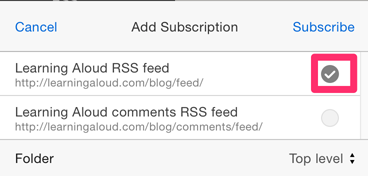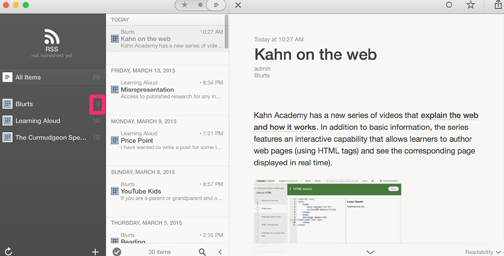Tactics - Blogging (Continued)
Personal Learning
Finding and Following Helpful Blogs
If you get into following blogs, it is very possible that the number of sites you find useful may reach 30, 40, or more. If these were traditional web sites, the time commitment on your part would be substantial. Just the time to move from blog to blog would be great and many times because bloggers post now and then when they have time and something to say, you would find that nothing new had been added.
There is a way to keep up with your favorite blogs in a much more efficient manner.
Most blog sites (and some other web resources) offer a useful feature called an RSS feed (real simple syndication). An RSS feed makes use of a special format called XML to make information about a blog available. A feed reader or “aggregator” is software that periodically visits a designated list of blogs, downloads the feeds, and uses the information contained in the feed to identify the blogs and the information contained in the blogs that have been updated since last visited by the individual who uses the aggregator software. So an aggregator keeps track of what is new on the blogs and what updates you have read recently using the aggregator software to determine what blog entries you have not viewed.
When you are ready to investigate the new information that is available, the process usually proceeds in stages. Once you connect to an aggregator:
- The aggregator first indicates which sites have new information.
- Depending on time and interest, you then click on a blog site with new information that you want to review and read the title and several lines of text from new posts shared by that site (the amount of material will vary with the blog server software used and the settings selected by the blog author).
- If a post seems interesting and the entire post is not provided, you then click on the post title and the entire post is made available.
Reeder 2 – Description of a Popular Aggregator
Reeder 2 - is one of the more popular blog aggregators. This is not a free application which I find acceptable after dealing with other aggregators that disappeared for one reason or another. Other aggregators are listed at the end of this section. Reeder is available for the Macintosh and iPad. The brief tutorial that follows is for the computer version of the service.
Setting up the aggregator
Reeder needs to know which web content you want it to follow. To create your list, you are going to add "subscriptions". To add a subscription, I first go to a blog that I want to follow and copy the address. Then, in the Reeder application, I locate "add subscription" under the Subscriptions menubar header.

The "add subscription" option opens a dialog box with a textbox for pasting the blog address I have copied into memory. Reeder will then attempt to contact this blog and if successful will indicate the feeds I can follow. Many blogs have a feed for the post content and for any comments on the posts. After selecting the desired feeds, I repeat the process with other blogs.


Reviewing Blogs Within an Aggregator
Viewing new blog posts follows a three step process. The service identifies:
- which blogs have been updated,
- the topics of new blog entries for a blog of interest, and
- access to the full post (and the blog).
If you take a look at the following image, you can imagine how this works. Blogs registered with Reeder appear in the left-most column. Following each blog is a number indicating the number of unread posts. Selecting one of the blogs will list titles for the unread posts in the second column. Selecting one of the titles will display the post associated with that title in the third column.
You can use the up and down arrows to move through the posts one by one. As you do this, the aggregator will consider each post viewed as read and the post will not appear the next time you open the aggregator.

Aggregators typically offer additional capabilities. For example, Reeder allows entries to be "starred" so that these posts do not disappear from the service even when read. Most aggregators also a way to export content. This capability provides an alternative to retaining valuable content within the aggregator.
Finding Blogs
If new to blogs, you may have few strategies for accumulating a list of blogs that make an aggregator useful. Again, the value of an aggregator is in scanning a large amount of content in order to identify a smaller number of posts for deeper consideration.
Here are a couple of ideas you might consider. First, many bloggers have what is typically called a "blog roll" associated with their own blogs. In a left or right-hand column of a blog, you might find a list of blogs the blogger follows. You might think of this as a recommendation list for you to consider.
Twitter (a microblog) is another productive source. Personally, the identification of resources is my main reason for using Twitter. Sharing useful resource is a common predictable activity and blog posts users find interesting are an example. Once I find someone who has interesting things to say, I add the blog he or she authors to my aggregator.
The creation of a productive aggregator reading list is a gradual process of additions and deletions.
Other Resources
Feedly is another popular aggregator you might consider. Feedly offers a free version and is cross platform. These characteristics might elevate Feedly as a choice among educators. I find Reeder 2 a little easier to use.